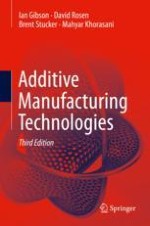2021 | OriginalPaper | Chapter
12. Hybrid Additive Manufacturing
Authors : Ian Gibson, David Rosen, Brent Stucker, Mahyar Khorasani
Published in: Additive Manufacturing Technologies
Publisher: Springer International Publishing
Activate our intelligent search to find suitable subject content or patents.
Select sections of text to find matching patents with Artificial Intelligence. powered by
Select sections of text to find additional relevant content using AI-assisted search. powered by
